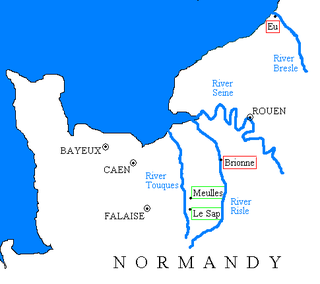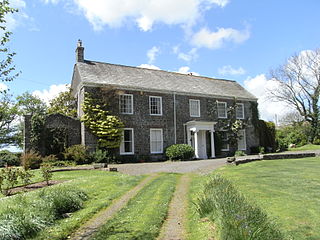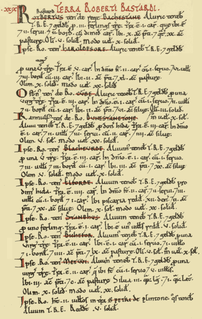Related Research Articles

Canonsleigh Abbey was an Augustinian priory in the parish of Burlescombe, Devon.

Baldwin FitzGilbert was a Norman magnate and one of the 52 Devon Domesday Book tenants-in-chief of King William the Conqueror, of whom he held the largest fiefdom in Devon, comprising 176 holdings or manors. He was feudal baron of Okehampton, seated at Okehampton Castle in Devon.
Richard Fitz Turold was an eleventh-century Anglo-Norman landowner in Cornwall and Devon, mentioned in the Domesday Book. In the 13th century his estates formed part of the Feudal barony of Cardinham, Cornwall, and in 1166 as recorded in the Cartae Baronum his estates had been held as a separate fiefdom from Reginald, Earl of Cornwall.

Huish is a small village, civil parish and former manor in the Torridge district of Devon, England. The eastern boundary of the parish is formed by the River Torridge and the western by the Rivers Mere and Little Mere, and it is surrounded, clockwise from the north, by the parishes of Merton, Dolton, Meeth and Petrockstowe. In 2001 the population of the parish was 49, down from 76 in 1901.

Collaton St Mary is a village, parish and former manor in Devon, England, situated about 2 miles (3 km) west of the town of Paignton. The village is bisected by the A385 Paignton to Totnes road. The parish is now administered within the unitary authority of Torbay, Devon.

The Manor of Monkleigh was a mediaeval manor centred on the village of Monkleigh in North Devon, England, situated 2 1/2 miles north-west of Great Torrington and 3 1/2 miles south-east of Bideford.
Walter I de Claville was an Anglo-Norman magnate and one of the 52 Devon Domesday Book tenants-in-chief of King William the Conqueror. He also held lands in Dorset. His Devonshire estates later formed part of the feudal barony of Gloucester.

The Domesday Book of 1086 lists in the following order the tenants-in-chief in Devonshire of King William the Conqueror:
William Cheever was one of the 52 Devon Domesday Book tenants-in-chief of King William the Conqueror. He held 46 landholdings in Devon. His lands later formed the feudal barony of Bradninch, Devon. His brother was Ralph de Pomeroy, feudal baron of Berry Pomeroy, Devon, with whom several of his holdings had been divided into two parts, one for each brother. His sister was Beatrix, who held from him the manor of Southleigh.

The feudal barony of Plympton was a large feudal barony in the county of Devon, England, whose caput was Plympton Castle and manor, Plympton. It was one of eight feudal baronies in Devonshire which existed during the medieval era. It included the so-called Honour of Christchurch in Hampshire, which was not however technically a barony. The de Redvers family, first holders of the barony, were also Lords of the Isle of Wight, which lordship was not inherited by the Courtenays, as was the barony of Plympton, as it had been sold to the king by the last in the line Isabel de Redvers, 8th Countess of Devon (1237–1293).

Thuborough in the parish of Sutcombe, Devon, England, is an historic estate, formerly a seat of a branch of the Prideaux family, also seated at Orcharton, Modbury; Adeston, Holbeton; Soldon, Holsworthy; Netherton, Farway; Ashburton; Nutwell, Woodbury; Ford Abbey, Thorncombe, all in Devon and at Prideaux Place, Padstow and Prideaux Castle, Luxulyan, in Cornwall. The present mansion house, comprising "Thuborough House" and "Thuborough Barton", the north-east block, is a grade II listed building.
Ralph de Pomeroy was one of the 52 Devon Domesday Book tenants-in-chief of King William the Conqueror and was the first feudal baron of Berry Pomeroy in Devon. He held 58 landholdings in Devon.

Stafford is an historic manor in the parish of Dolton in Devon, England. The present manor house known as Stafford Barton is a grade II* listed building. A house of some form has existed on the manor probably since the Norman Conquest in the 11th century. Surviving walls can be dated to the 16th century. Many additions and renovations have taken place in the intervening years, and in the early 20th century Charles Luxmoore made many alterations and extensions and imported several major architectural features from ancient local mansions undergoing demolition so that "it has become somewhat difficult to discern its original form". In the nineteenth century the estate was very substantial, with 400 acres of associated farmland and a large staff, and by 1956, at the end of the Luxmoore tenure, it had grown to 1,460 acres with 7 farms, several cottages and smallholdings.

Washfield is a village, parish and former manor in Devon, England, situated about 2 miles north-west of Tiverton. The parish church is dedicated to St Mary the Virgin. It was within the jurisdiction of the historic West Budleigh Hundred.
Ansger of Montacute was one of the Devon Domesday Book tenants-in-chief of King William the Conqueror.
Luscombe is an historic estate situated in the parish of Rattery in Devon.
Alfred the Breton was one of the Devon Domesday Book tenants-in-chief of King William the Conqueror. He had 22 landholdings in the county of Devonshire held in-chief according to the Domesday Book of 1086, and held further lands as a mesne tenant, including the manor of Panson in the parish of St Giles-in-the-Heath. His manors later descended to the feudal barony of Plympton.

Robert Bastard (fl.1086) was a Norman warrior who assisted in the 1066 Norman Conquest of England under King William the Conqueror. He was subsequently rewarded with landholdings in Devonshire and is one of the Devon Domesday Book tenants-in-chief of that monarch, with a holding of 10 manors or estates held in chief, 8 of which he held in demesne, i.e. under his own management without tenants. He had at least one further holding as a mesne tenant, at Goosewell, Plymstock parish, Plympton hundred, held from William of Poilley, a Norman tenant-in-chief from Poilley in Normandy, most of whose 21 landholdings were later granted by King Henry I (1100–1135) to his trusted supporter Richard de Redvers, feudal baron of Plympton in Devon.
Erchenbald or Archembald was a mesne lord listed in the Domesday Book of 1086 as a tenant of nine manors in Devon and Cornwall, England. He is believed to be the first English ancestor of the prominent Fleming family.
Nicholas the Bowman (fl.1086), also known as Nicholas de la Pole, was a servant of King William the Conqueror (1066-1087) and was one of that king's Devon Domesday Book tenants-in-chief. He was also a tenant-in-chief in Warwickshire and at some time between 1095 and 1100 he exchanged his manor of Ailstone in Warwickshire for the manor of Plymtree in Devon, held by St Peter's Abbey, Gloucester.